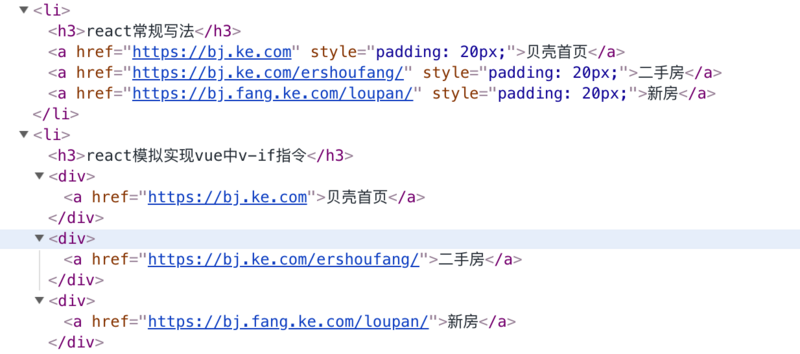您好,登录后才能下订单哦!
这篇文章将为大家详细讲解有关React碰到v-if的示例分析,小编觉得挺实用的,因此分享给大家做个参考,希望大家阅读完这篇文章后可以有所收获。
代码:
import React from 'react'
const App = () => {
const record = {
toKe: true, // 贝壳首页
toSecondHand: true, // 二手房
toFang: true, // 新房
}
return (
<div style={{width: 600, margin: '50px auto'}}>
<ul>
<li>
<h4>react常规写法</h4>
{
record.toKe
? <a style={{padding: 20}} href="https://bj.ke.com" rel="external nofollow" rel="external nofollow" rel="external nofollow" rel="external nofollow" rel="external nofollow" >贝壳首页</a>
: null
}
{
record.toSecondHand
? <a style={{padding: 20}} href="https://bj.ke.com/ershoufang/" rel="external nofollow" rel="external nofollow" rel="external nofollow" rel="external nofollow" rel="external nofollow" >二手房</a>
: null
}
{
record.toFang
? <a style={{padding: 20}} href="https://bj.fang.ke.com/loupan/" rel="external nofollow" rel="external nofollow" rel="external nofollow" rel="external nofollow" rel="external nofollow" >新房</a>
: null
}
</li>
</ul>
</div>
)
}
export default App如上述代码,我们在项目中会遇到很多这样的写法, 细看一下没什么问题,可是当在重构老项目的时候,你会发现这个代码结构是多么痛苦,特别是如下的结构。
{
record.toFang && record.toKe && record.toSecondHand
&& <div>
<a style={{padding: 20}} href="https://bj.ke.com" rel="external nofollow" rel="external nofollow" rel="external nofollow" rel="external nofollow" rel="external nofollow" >贝壳首页</a>
<a style={{padding: 20}} href="https://bj.ke.com/ershoufang/" rel="external nofollow" rel="external nofollow" rel="external nofollow" rel="external nofollow" rel="external nofollow" >二手房</a>
<a style={{padding: 20}} href="https://bj.fang.ke.com/loupan/" rel="external nofollow" rel="external nofollow" rel="external nofollow" rel="external nofollow" rel="external nofollow" >新房</a>
</div>
}虽然代码逻辑没问题,但人生就是这样,有时候出场顺序真的很重要。突然就想起vue的v-if了。
没错,回归主题,就是:react中模拟vue的v-if
先上代码
import React from 'react'
import Hidden from './Hidden'
const App = () => {
const record = {
toKe: true, // 贝壳首页
toSecondHand: true, // 二手房
toFang: true, // 新房
}
return (
<div style={{width: 600, margin: '50px auto'}}>
<ul>
<li>
<h4>react模拟实现vue中v-if指令</h4>
<Hidden visible={record.toKe} tag='span'>
<a href="https://bj.ke.com" rel="external nofollow" rel="external nofollow" rel="external nofollow" rel="external nofollow" rel="external nofollow" >贝壳首页</a>
</Hidden>
<Hidden visible={record.toSecondHand} tag='span' style={{padding: 20}}>
<a href="https://bj.ke.com/ershoufang/" rel="external nofollow" rel="external nofollow" rel="external nofollow" rel="external nofollow" rel="external nofollow" >二手房</a>
</Hidden>
<Hidden visible={record.toFang} tag='p'>
<a href="https://bj.fang.ke.com/loupan/" rel="external nofollow" rel="external nofollow" rel="external nofollow" rel="external nofollow" rel="external nofollow" >新房</a>
</Hidden>
</li>
</ul>
</div>
)
}
export default App简单就是封装Hidden组件,通过visible去控制是否渲染。
相信聪明的你一定知道怎么去封装Hidden
笔者刚开始是这么写的
import React, { Component } from 'react'
export default class Hidden extends Component {
render() {
const { visible, children } = this.props
const content = visible ? children : null
return (
<div>
{ content }
</div>
)
}
}如此简单,但笔者审查元素的时候发现,每个Hidden下的children莫名被嵌套了一层div
如下

原来的横着排列的元素,一下子竖着排列了。这可不太好,本来给我套个div,我都可以勉强接收,现在连我布局都给我变了。
怎么办?笔者突然想到使用vue-router中的router-link时,标签是可以通过tag去替换默认标签的。
那我们再给它个tag呗,连带自定义属性。
import React, { Component } from 'react'
export default class Hidden extends Component {
render() {
const { visible, children, tag = 'div', ...rest } = this.props
const content = visible ? children : null
return (
React.createElement(tag, rest, content)
)
// return (
// 尝试用这种方法去实现,发现不符合react的规则,所以使用最原始的渲染方法
// React.createElement
// `<`${tag}`>` + { content } + `</`${tag}`>`
// )
}
}问题:笔者的初衷是模拟vue的v-if, 所以对传入的children并没做太多处理,不建议做多做封装。有兴趣的同学可以自己玩。
{
record.toFang && record.toKe && record.toSecondHand
&& <span>
<a style={{padding: 20}} href="https://bj.ke.com" rel="external nofollow" rel="external nofollow" rel="external nofollow" rel="external nofollow" rel="external nofollow" >贝壳首页</a>
<a style={{padding: 20}} href="https://bj.ke.com/ershoufang/" rel="external nofollow" rel="external nofollow" rel="external nofollow" rel="external nofollow" rel="external nofollow" >二手房</a>
<a style={{padding: 20}} href="https://bj.fang.ke.com/loupan/" rel="external nofollow" rel="external nofollow" rel="external nofollow" rel="external nofollow" rel="external nofollow" >新房</a>
</span>
}
<Hidden
visible={record.toFang && record.toKe && record.toSecondHand}
tag='span'>
a href="https://bj.ke.com" rel="external nofollow" rel="external nofollow" rel="external nofollow" rel="external nofollow" rel="external nofollow" >贝壳首页</a>
<a style={{padding: 20}} href="https://bj.ke.com/ershoufang/" rel="external nofollow" rel="external nofollow" rel="external nofollow" rel="external nofollow" rel="external nofollow" >二手房</a>
<a style={{padding: 20}} href="https://bj.fang.ke.com/loupan/" rel="external nofollow" rel="external nofollow" rel="external nofollow" rel="external nofollow" rel="external nofollow" >新房</a>
</Hidden>其实感觉也没多大用处hhhh
关于“React碰到v-if的示例分析”这篇文章就分享到这里了,希望以上内容可以对大家有一定的帮助,使各位可以学到更多知识,如果觉得文章不错,请把它分享出去让更多的人看到。
免责声明:本站发布的内容(图片、视频和文字)以原创、转载和分享为主,文章观点不代表本网站立场,如果涉及侵权请联系站长邮箱:is@yisu.com进行举报,并提供相关证据,一经查实,将立刻删除涉嫌侵权内容。